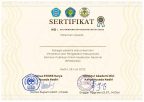Hubungan Pola Konsumsi dengan Siklus Menstruasi pada Mahasiswa Akademi Gizi Karya Husada Kediri
Keywords:
Consumption Pattern, Menstrual Cycle, StudentsAbstract
Poor consumption patterns will interfere with the production of the hormones estrogen, and progesterone and reduce the production of Gonadotropin-Releasing Hormone (GnRH) so that it can inhibit the occurrence of menstruation. The purpose of this study was to determine the relationship between consumption patterns and the menstrual cycle in the students of the Karya Husada Kediri Academy of Nutrition. The research design used is analytic with a cross-sectional approach using Spearman Rank correlation with a significant level of = 0.05. The population of this study was the students of the Academy of Nutrition of Karya Husada Kediri levels 1, 2, and 3 as many as 71 respondents. The sample used is 61 respondents using a simple random sampling technique. Data were collected using 24-hour recall, FFQ, and questionnaires. The results showed that students with less energy intake were 10 people (28.6%), students with more protein intake were 4 people (14.8%), students rarely consumed staple foods as many as 3 (33.3%), students 7 people rarely eat animal side dishes (38.9%), 9 students rarely eat vegetable side dishes (20.9%), 7 students rarely eat vegetables (26.9%), 3 students rarely eat fruit (30%), there were 5 students with the type of food ingredients not according to PGS (20%). The results of the Spearmen Rank statistical test showed that there was no relationship between consumption patterns and menstrual cycles for the students of the Karya Husada Kediri Academy of Nutrition in terms of energy intake (p = 0.390), protein intake (p = 0.070), frequency of consuming staple foods (p = 0.431), frequency of consuming animal side dishes (p = 0.057), frequency of consuming vegetable side dishes (p = 0.569), frequency of consuming vegetables (p = 0.533), frequency of consuming fruit (p = 0.570), types of food ingredients (p = 0.654). It is expected that students who have fewer consumption patterns can improve their consumption patterns by improving diverse consumption patterns by increasing the consumption of staple foods, side dishes, vegetables, and fruit both in quantity and quality.
Downloads
Published
Issue
Section
License
Copyright (c) 2022 Prosiding SPIKesNas : Seminar Publikasi Ilmiah Kesehatan Nasional

This work is licensed under a Creative Commons Attribution 4.0 International License.







